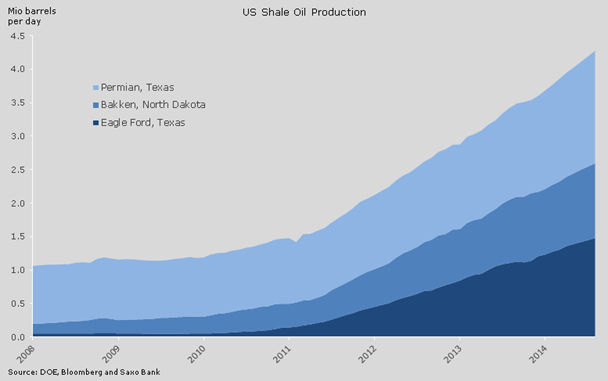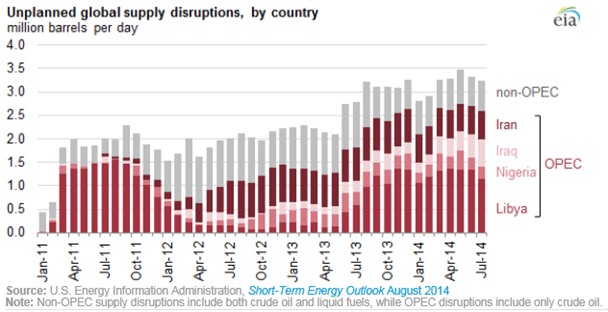A new report from the US Energy Information Administration highlights the extraordinary rise in US liquid fuel production over the past few years and how it has helped off-set unplanned supply disruptions which are running at the highest level since the Iraq-Kuwait war some 24 years ago.
The report has done a very good job in clearly describing what we already knew, namely that oil markets since 2011 have become less price sensitive to actual and potential supply disruptions. Especially to those numerous geopolitical events that has taken place since the Arab spring and the overthrow of Libya's Muammar Gaddaffi in 2011.
From 2011 up until this July, US production of liquid fuels − crude oil, gas liquids and biofuels − grew by more than four million barrels per day. Of this, three million barrels came from the growth in crude oil production, primarily from new unconventional production techniques such as shale oil extraction.
The chart below shows the phenomenal rise in shale oil production from the three biggest areas of production in Texas and North Dakota. The rise in shale oil production is currently expected to continue up until 2020 after which time it will stabilise before falling the next decade. Continued high prices or a reduction in extraction cost from continued innovations in production techniques will be required for this to happen.
 Turning to supply disruptions, the EIA estimates that global unplanned supply disruptions averaged 3.2 million b/d during the first seven months of 2014. Of these, a vast majority came from OPEC producing nations, especially Libya, Iran and Iraq. Libya saw its production collapse last August when rebels began a year-long harbour blockade which has only now begun to be lifted. Iran's production was cut back in 2012 following the introduction of Western sanctions in response to the uncertainty over the country's nuclear intentions.
Turning to supply disruptions, the EIA estimates that global unplanned supply disruptions averaged 3.2 million b/d during the first seven months of 2014. Of these, a vast majority came from OPEC producing nations, especially Libya, Iran and Iraq. Libya saw its production collapse last August when rebels began a year-long harbour blockade which has only now begun to be lifted. Iran's production was cut back in 2012 following the introduction of Western sanctions in response to the uncertainty over the country's nuclear intentions.
 Talks between Iran and a group of Western countries together with China and Russia have been ongoing since last year and today, the Russian Foreign Ministry in a statement expressed some optimism that the talks could lead to an eventual lifting.
The result of increased US production and subsequent rise in exports of products have triggered reduced demand for foreign imports, especially from producers in Africa. This has helped to create a supply glut in the Atlantic basin which is the main reason why crude oil has come under some selling pressure in recent weeks and why Brent crude oil has seen the price of spot crude fall below deferred for the first time since 2010.
Brent crude oil, the current benchmark for the price setting of a majority of global oil transaction has now been averaging $110/b since 2011. While we have seen price spikes and major sell-offs during this time, volatility has continued to come down as the increase in non-OPEC production has helped reduce the risk in the market.
The chart below shows how the oil price has behaved during numerous geopolitical events since 2011 and what is telling is that peaks have become more and more shallow with big producers such as Saudi Arabia having been able to meet any potential short falls and thereby help maintain a steady price. Following each peak, speculative traders such as hedge funds were forced to exit loss-making positions and this, at least up until the current sell-off, has been the main driver behind the price slumps.
Talks between Iran and a group of Western countries together with China and Russia have been ongoing since last year and today, the Russian Foreign Ministry in a statement expressed some optimism that the talks could lead to an eventual lifting.
The result of increased US production and subsequent rise in exports of products have triggered reduced demand for foreign imports, especially from producers in Africa. This has helped to create a supply glut in the Atlantic basin which is the main reason why crude oil has come under some selling pressure in recent weeks and why Brent crude oil has seen the price of spot crude fall below deferred for the first time since 2010.
Brent crude oil, the current benchmark for the price setting of a majority of global oil transaction has now been averaging $110/b since 2011. While we have seen price spikes and major sell-offs during this time, volatility has continued to come down as the increase in non-OPEC production has helped reduce the risk in the market.
The chart below shows how the oil price has behaved during numerous geopolitical events since 2011 and what is telling is that peaks have become more and more shallow with big producers such as Saudi Arabia having been able to meet any potential short falls and thereby help maintain a steady price. Following each peak, speculative traders such as hedge funds were forced to exit loss-making positions and this, at least up until the current sell-off, has been the main driver behind the price slumps.

- English (UK)
- English (India)
- English (Canada)
- English (Australia)
- English (South Africa)
- English (Philippines)
- English (Nigeria)
- Deutsch
- Español (España)
- Español (México)
- Français
- Italiano
- Nederlands
- Português (Portugal)
- Polski
- Português (Brasil)
- Русский
- Türkçe
- العربية
- Ελληνικά
- Svenska
- Suomi
- עברית
- 日本語
- 한국어
- 简体中文
- 繁體中文
- Bahasa Indonesia
- Bahasa Melayu
- ไทย
- Tiếng Việt
- हिंदी
How The US Found An 'Extraordinary' Solution To Oil Supply Risk
Published 08/28/2014, 06:48 AM
Updated 03/19/2019, 04:00 AM
How The US Found An 'Extraordinary' Solution To Oil Supply Risk
3rd party Ad. Not an offer or recommendation by Investing.com. See disclosure here or
remove ads
.
Latest comments
Install Our App
Risk Disclosure: Trading in financial instruments and/or cryptocurrencies involves high risks including the risk of losing some, or all, of your investment amount, and may not be suitable for all investors. Prices of cryptocurrencies are extremely volatile and may be affected by external factors such as financial, regulatory or political events. Trading on margin increases the financial risks.
Before deciding to trade in financial instrument or cryptocurrencies you should be fully informed of the risks and costs associated with trading the financial markets, carefully consider your investment objectives, level of experience, and risk appetite, and seek professional advice where needed.
Fusion Media would like to remind you that the data contained in this website is not necessarily real-time nor accurate. The data and prices on the website are not necessarily provided by any market or exchange, but may be provided by market makers, and so prices may not be accurate and may differ from the actual price at any given market, meaning prices are indicative and not appropriate for trading purposes. Fusion Media and any provider of the data contained in this website will not accept liability for any loss or damage as a result of your trading, or your reliance on the information contained within this website.
It is prohibited to use, store, reproduce, display, modify, transmit or distribute the data contained in this website without the explicit prior written permission of Fusion Media and/or the data provider. All intellectual property rights are reserved by the providers and/or the exchange providing the data contained in this website.
Fusion Media may be compensated by the advertisers that appear on the website, based on your interaction with the advertisements or advertisers.
Before deciding to trade in financial instrument or cryptocurrencies you should be fully informed of the risks and costs associated with trading the financial markets, carefully consider your investment objectives, level of experience, and risk appetite, and seek professional advice where needed.
Fusion Media would like to remind you that the data contained in this website is not necessarily real-time nor accurate. The data and prices on the website are not necessarily provided by any market or exchange, but may be provided by market makers, and so prices may not be accurate and may differ from the actual price at any given market, meaning prices are indicative and not appropriate for trading purposes. Fusion Media and any provider of the data contained in this website will not accept liability for any loss or damage as a result of your trading, or your reliance on the information contained within this website.
It is prohibited to use, store, reproduce, display, modify, transmit or distribute the data contained in this website without the explicit prior written permission of Fusion Media and/or the data provider. All intellectual property rights are reserved by the providers and/or the exchange providing the data contained in this website.
Fusion Media may be compensated by the advertisers that appear on the website, based on your interaction with the advertisements or advertisers.
© 2007-2024 - Fusion Media Limited. All Rights Reserved.
